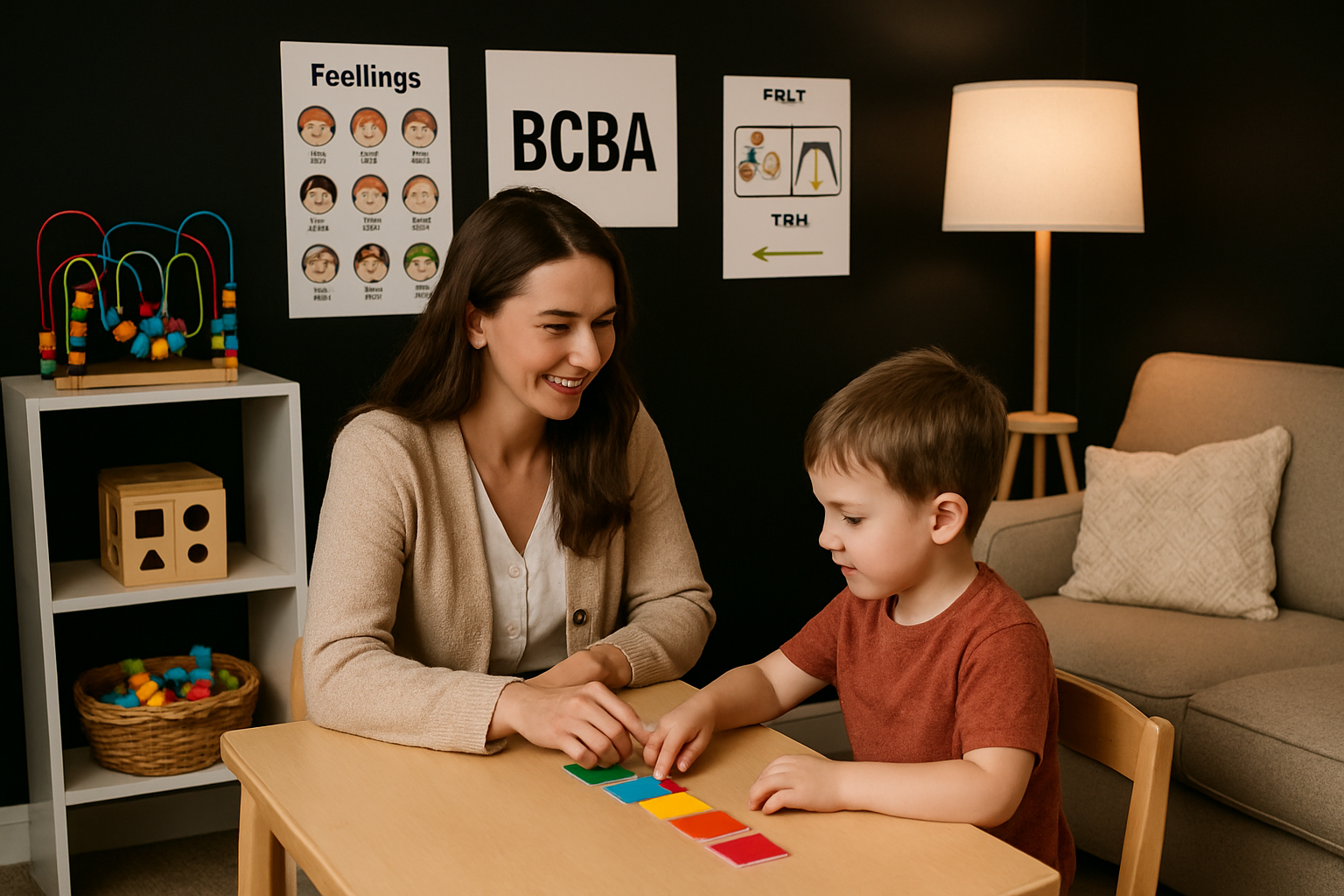Imagine a world where every child with autism or developmental disabilities receives the support they need to thrive. In 2025, bcba services are creating real change for families, helping children build vital skills and confidence. This guide breaks down what bcba services are, why they matter, and how you can access them. Whether you're a parent, caregiver, or new to ABA therapy, you'll learn how to evaluate providers and maximize positive outcomes. Ready to discover how expert guidance and proven strategies can transform your journey? Let’s get started.
WHAT ARE BCBA SERVICES?
Board Certified Behavior Analyst (BCBA) services are specialized supports designed to help individuals with autism and other developmental disabilities reach their full potential. At their core, bcba services focus on understanding why behaviors occur and teaching new, positive skills. These services are not only for children—teens and adults with developmental needs, as well as their families, can also benefit.

DEFINITION AND OVERVIEW
A BCBA is a highly trained professional who holds a graduate-level certification in behavior analysis. This credential signals expertise in designing and overseeing behavioral interventions that are rooted in science. When you choose bcba services, you are working with a provider who understands how to assess behavior, create tailored plans, and track progress.
There are several roles within the field. Here’s a quick comparison:
| Role | Education Required | Main Responsibilities |
| BCBA | Master's degree + exam | Assessment, plan development, supervision |
| BCaBA | Bachelor's degree + exam | Assist BCBA, some supervision |
| RBT | High school + training | Direct implementation, data collection |
WHY BCBA SERVICES MATTER
BCBA services can benefit a wide range of individuals. Most commonly, families with a child diagnosed with autism seek these supports. However, bcba services also help those with ADHD, intellectual disabilities, or behavioral challenges at school or home.
Applied Behavior Analysis (ABA) is the foundation of bcba services. ABA uses principles of learning and motivation to bring about positive change. If you’re new to this approach, you can explore Applied Behavior Analysis basics for an accessible introduction.
A BCBA’s responsibilities include:
- Conducting comprehensive assessments to identify strengths and needs.
- Developing individualized behavior intervention plans.
- Supervising and training Registered Behavior Technicians (RBTs) and other staff.
- Analyzing data and making adjustments based on results.
These services are typically delivered in various settings, such as clinics, homes, schools, and community centers. For example, a young child with autism might receive bcba services in a clinic, focusing on building social skills like greeting peers or sharing toys.
The Science Behind ABA and BCBA Services
Bcba services are grounded in the principles of ABA, which is widely recognized for its effectiveness in changing behavior. The science behind these services lies in understanding how environmental factors influence actions and how positive reinforcement can shape new skills.
One of the hallmarks of bcba services is the creation of individualized, data-driven treatment plans. Every goal is tailored to the client’s unique strengths and needs. BCBAs collect and analyze data regularly, ensuring that interventions are effective and adjusted as needed.
The evidence for ABA is strong. According to recent data from the CDC and Autism Speaks, children who receive early and intensive ABA-based bcba services often show significant improvements in communication, daily living skills, and independence. For instance, a child who was initially nonverbal may learn to request items or express needs after consistent intervention.
Here’s what families can expect from bcba services:
- Increased independence in daily routines
- Enhanced communication abilities
- Reduction in challenging behaviors
- Greater success in school and social settings
By focusing on measurable outcomes and ongoing collaboration, bcba services offer real hope and tangible results for families beginning their journey.
THE ROLE OF THE BCBA: DUTIES, ETHICS, AND COLLABORATION
Board Certified Behavior Analysts (BCBAs) are at the heart of effective bcba services, guiding individuals and families through the journey of positive behavior change. Their expertise shapes every aspect of care, from assessment to collaboration, ensuring that support is both ethical and impactful.
Core Duties and Responsibilities
The BCBA is the clinical leader of the therapeutic team. Their duties are multifaceted and require a high degree of clinical judgment:
- Assessment and Goal Setting: BCBAs use standardized assessment tools (like the VB-MAPP or ABLLS-R) to determine the client's current skill levels. They then collaborate with the family to set socially significant, measurable, achievable, relevant, and time-bound (SMART) goals.
- Program Design and Modification: They write the detailed treatment plan, defining which evidence-based procedures will be used to teach new skills or reduce problem behaviors. They continuously analyze the data collected during sessions to make necessary program adjustments (data-driven decision-making).
- Supervision and Training: A BCBA is responsible for the competency and ethical practice of the RBTs and BCaBAs who work directly with the client. They provide rigorous training and frequent, direct supervision to ensure the plan is implemented correctly.
- Caregiver Coaching: They train parents, caregivers, and teachers on how to use ABA strategies effectively. This is crucial for generalization, ensuring the client uses newly learned skills across all environments (home, school, community).
Ethical Obligations
BCBAs adhere to a strict Ethics Code set by the Behavior Analyst Certification Board (BACB). This ensures the client's rights, dignity, and well-being are always the highest priority. Key ethical considerations include:
- Client Dignity and Rights: Ensuring all procedures are humane, respectful, and minimally restrictive.
- Informed Consent: Clearly explaining all proposed interventions and obtaining documented consent from the client or guardian before beginning treatment.
- Confidentiality: Protecting the privacy of the client and their family in accordance with professional and legal standards (like HIPAA in the U.S.).
- Professional Competence: Only working within the boundaries of their education, training, and supervised experience.
Collaboration and Teamwork
Effective BCBA services rely heavily on collaboration. The BCBA works as a central coordinator, communicating regularly with:
- Family Members: To ensure goals align with family priorities and to promote consistency across settings.
- Other Therapists: (e.g., Speech-Language Pathologists, Occupational Therapists) to create a cohesive, integrated treatment plan where therapeutic goals complement each other.
- School Personnel: To help generalize skills into the educational environment and assist in developing effective Individualized Education Programs (IEPs).
The BCBA’s commitment to ethical, evidence-based, and collaborative practice is what drives the profound positive changes seen in clients and their families.

THE ROLE OF THE BCBA: DUTIES, ETHICS, AND COLLABORATION
Core Duties and Responsibilities
BCBA services begin with a thorough understanding of each client's unique needs. BCBAs conduct detailed behavioral assessments and functional analyses, using observation and standardized tools to identify strengths and challenges. This information forms the backbone of individualized intervention plans tailored to the person's goals.
Designing and implementing these plans is a central duty. BCBAs not only develop strategies for skill acquisition and behavior reduction but also supervise Registered Behavior Technicians (RBTs) and other paraprofessionals who carry out day-to-day interventions. They monitor progress through ongoing data collection, making timely adjustments to ensure interventions remain effective.
Documentation and clear communication are essential. BCBAs maintain detailed records, provide regular updates, and collaborate with families, educators, and healthcare professionals to keep everyone aligned. For a deeper dive into these responsibilities, see The BCBA role explained.
Ethics and Professional Standards
Upholding the highest ethical standards is a cornerstone of bcba services. BCBAs follow the Behavior Analyst Certification Board (BACB) Professional and Ethical Compliance Code, which emphasizes integrity, transparency, and respect for client rights. This includes obtaining informed consent for all assessments and interventions, protecting confidentiality, and ensuring the dignity of every client. Cultural competence is vital. BCBAs recognize the diverse backgrounds of families and adapt their approaches to fit cultural values and traditions. They actively seek input from clients and their support networks, making sure interventions are relevant and respectful. For example, when working within multicultural communities, BCBAs may adjust communication styles, involve extended family members, or incorporate culturally significant routines into therapy. This personalized care ensures bcba services truly meet the needs of every individual.
The Collaborative Model
Collaboration is a defining feature of high-quality bcba services. BCBAs work closely with parents, teachers, and allied professionals to create a unified support system around the client. Parent and caregiver training is not just an add-on, but a critical component—empowering families to reinforce new skills and strategies at home and beyond.
Regular team meetings foster open dialogue and problem-solving. For instance, in one case study, a BCBA partnered with classroom teachers and a child’s parents to address disruptive behaviors. By aligning strategies, sharing data, and providing consistent support, the team saw marked improvements in classroom participation and peer interactions.
Through this collaborative approach, bcba services extend beyond the clinic or classroom, helping clients achieve meaningful progress in all areas of life.
TYPES OF BCBA SERVICES AND DELIVERY MODELS
Understanding the variety of bcba services available can help families make informed choices that fit their needs. Services are designed to be flexible, adapting to the unique strengths and challenges of each individual. The delivery model and intensity can significantly impact progress, so it’s important to know your options from the start.
Service Delivery Models
BCBA services can be delivered in several different environments, with the choice often depending on the client’s age, specific goals, and insurance coverage.

TYPES OF BCBA SERVICES AND DELIVERY MODELS
Understanding the variety of bcba services available can help families make informed choices that fit their needs. Services are designed to be flexible, adapting to the unique strengths and challenges of each individual. The delivery model and intensity can significantly impact progress, so it’s important to know your options from the start.
Service Delivery Models
BCBA services can be delivered in several different environments, with the choice often depending on the client’s age, specific goals, and insurance coverage. Model Description Best for Clinic-Based (Center-Based) Services provided at a specialized ABA clinic. Offers a structured environment with access to a wide range of materials, equipment, and opportunities for social interaction with peers. Early learners, intensive skill acquisition, and those needing a structured, distraction-controlled setting. In-HomeServices provided in the client's natural home environment. Allows the BCBA to train family members directly and address skills (like chores, hygiene, or bedtime routines) in the exact place where they are needed. Generalization of skills, daily living skills, and behavior reduction for home-specific issues. School-Based Services provided within the school setting, often in collaboration with the Individualized Education Program (IEP) team. Focuses on social skills with peers, classroom behaviors, and academic readiness. Students needing support with academic or social integration, school-specific challenging behaviors. Community-Based Services provided in public settings like parks, stores, or restaurants. Aims to generalize skills to real-world situations, such as navigating a grocery store or interacting with cashiers. Older children, teens, and adults focusing on vocational, leisure, and public safety skills. Comprehensive vs. Focused ABA Services
BCBA services are typically offered as either comprehensive or focused ABA programs. Comprehensive ABA involves 30–40 hours per week and targets a broad range of skills, such as communication, socialization, and adaptive behaviors.1 This model is often recommended for young children or those with significant needs.
Focused ABA, on the other hand, provides 10–20 hours per week and addresses specific goals, like improving social skills or reducing challenging behaviors. This approach is ideal for individuals who need support in targeted areas rather than across all developmental domains.
Here’s a quick comparison:
| Service Type | Hours/Week | Target Areas | Best For |
| Comprehensive ABA | 30-40 | Multiple, across domains | Early intervention, broad needs |
| Focused ABA | 10-20 | Specific, targeted skills | Older children, specific goals |
Choosing between these types of BCBA services depends on assessment results, clinical recommendations, and family priorities. To learn more about what each model includes, see this ABA services overview.
Service Settings: Clinic-Based, In-Home, and School-Based
Bcba services are delivered in various settings to maximize effectiveness and generalization. Each environment offers unique benefits and challenges.
Clinic-Based:
- Pros: Structured, distraction-free; access to specialized equipment.
- Cons: May lack real-life context; transportation required.
In-Home:
- Pros: Skills taught in natural environment; family involvement.
- Cons: Potential for more distractions; limited resources.
School-Based:
- Pros: Integration with educational goals; collaboration with teachers.
- Cons: Less individualized attention; school schedules may limit flexibility.
Natural environment teaching (NET), often used in in-home and community settings, helps individuals apply new skills in daily life. As more families seek personalized support, there’s a growing trend toward in-home and community-based bcba services, allowing for greater flexibility and relevance to everyday challenges.
Additional Service Models
Beyond one-on-one therapy, bcba services can include group-based interventions, telehealth, and parent or caregiver training.
- Group-Based Interventions: Social skills groups help children practice communication and cooperation with peers. These groups are typically led by a BCBA and target skills like sharing, turn-taking, and emotional regulation.
- Telehealth: Remote delivery of bcba services allows families in rural or underserved areas to access expert guidance. Telehealth can include live video sessions, parent coaching, and progress monitoring.
- Parent/Caregiver Training: Empowering families is a key part of effective bcba services. Training programs teach caregivers strategies to reinforce skills at home, manage challenging behaviors, and support ongoing progress.
By offering a range of service models, bcba services can be tailored to each family's preferences, needs, and cultural context. This flexibility ensures support is accessible and effective, regardless of where you are on your journey.
HOW TO ACCESS AND START BCBA SERVICES: STEP-BY-STEP GUIDE
Starting the journey with bcba services can feel overwhelming, but breaking it down into manageable steps makes the process clear and achievable. Whether you’re a parent, caregiver, or newcomer, this guide will walk you through each stage, helping you access the support you need for your loved one.

Step 1: Identifying the Need for BCBA Services
Recognizing when bcba services may be beneficial is the first step. Early signs can include delayed speech, difficulties with social interaction, repetitive behaviors, or challenges with daily routines.
Common indicators to watch for:
- Limited eye contact or difficulty engaging with others
- Trouble adapting to changes in routine
- Repetitive movements or behaviors
- Delays in communication or self-care skills
If you notice these behaviors in your child or loved one, it’s important to seek guidance. Early access to bcba services leads to better long-term outcomes. Trust your instincts and remember, you’re not alone on this path.
Step 2: Getting a Referral or Diagnosis
To begin bcba services, most families need a formal diagnosis, such as autism spectrum disorder or another developmental condition. This typically involves meeting with a pediatrician, psychologist, or qualified healthcare provider.
The referral process usually includes:
- Developmental screening by your child’s doctor
- Assessment by a specialist if concerns are identified
- Completion of diagnostic evaluations, often involving standardized tests and parent interviews
Insurance companies and funding programs often require this documentation before approving bcba services. Keep all reports and paperwork organized, as you’ll need them throughout the process.
Step 3: Finding a Qualified BCBA Provider
Selecting the right professional for bcba services is crucial. Look for providers who are Board Certified Behavior Analysts (BCBAs) with active certification from the Behavior Analyst Certification Board (BACB) and, when required, state licensure.
What to look for:
- BACB certification and up-to-date credentials
- Experience with your child’s age group and needs
- Positive reviews or recommendations from other families
Verifying credentials ensures your provider meets the standards for effective bcba services. For a step-by-step walkthrough of this process, visit the How to get started with ABA resource, which offers guidance tailored for new families.
Step 4: Initial Assessment and Goal Setting
Once you’ve chosen a provider, the next phase of bcba services is the initial assessment. This in-depth process helps the BCBA understand your child’s strengths, needs, and environment.
Assessments may include:
- Functional behavior assessments (FBA) to determine the reasons for challenging behaviors
- Skill inventories to identify current abilities and gaps
- Interviews with parents, teachers, and caregivers
Together with your BCBA, you’ll set measurable goals that reflect your child’s unique needs. This collaborative approach ensures BCBA services are tailored and meaningful.
Step 5: Developing and Implementing the Treatment Plan
The heart of bcba services lies in designing and launching an individualized treatment plan. Your BCBA will use assessment data to create a plan targeting specific skills, behaviors, and outcomes.
Key elements of the treatment plan:
- Step-by-step strategies for teaching new skills
- Positive reinforcement techniques
- Clear, measurable objectives
Family involvement is essential. You’ll learn how to reinforce new skills at home and provide feedback to the BCBA, making bcba services a true partnership.
Step 6: Monitoring Progress and Adjusting Interventions
Ongoing evaluation is a hallmark of effective bcba services. Progress is tracked through regular data collection, observation, and communication with families.
What to expect:
- Frequent check-ins and progress reports
- Data-driven adjustments to strategies as your child grows
- Opportunities to discuss concerns and celebrate successes
This step ensures that bcba services remain responsive, maximizing your child’s potential at every stage.
Step 7: Transitioning and Fading Services
As your child meets goals and gains independence, bcba services are gradually reduced. The transition plan is carefully tailored to support success in new settings, such as school or community activities.
Transition strategies may include:
- Gradually decreasing session frequency
- Training teachers or community members to reinforce skills
- Preparing your child for new routines and environments
The ultimate aim of bcba services is to empower long-term independence. Your BCBA will provide resources and support to ensure a smooth transition and continued growth.
CHOOSING THE RIGHT BCBA PROVIDER: WHAT TO LOOK FOR
Choosing the right provider for bcba services is a critical decision for families seeking effective support. The right fit can make a lasting difference in your child’s progress and overall experience. Here’s how to evaluate the key factors that matter most.
Evaluating Provider Qualifications and Experience
Start by confirming your provider’s credentials. Board certification is a must for anyone delivering bcba services. Check for active certification with the Behavior Analyst Certification Board (BACB) and verify state licensure if required.
Experience matters, too. Ask about the provider’s background working with children of similar ages or diagnoses. Some BCBAs specialize in early intervention, while others focus on teens or specific challenges.
Continuing education is another sign of quality. Providers should stay current with best practices and new research. With the growing demand for bcba services, as shown in BCBA job growth statistics, it’s more important than ever to ensure your provider stands out through proven expertise.
Assessing Service Delivery and Communication
Transparent communication is a cornerstone of effective BCBA services. Your provider should involve you in every step, from assessment to goal setting and progress updates.
Look for regular reports and meetings. Providers should explain how they measure progress and adjust plans as needed. Ask about opportunities for parent training and support.
Family collaboration is key. The best providers encourage questions and welcome your input. Clear communication helps you feel confident and empowered throughout your journey with BCBA services.
Cultural Sensitivity and Accessibility
A great provider of BCBA services values cultural competence and inclusivity. Ask about language options, interpreter availability, and experience working with families from diverse backgrounds.
Cultural sensitivity ensures that therapy plans respect your values and traditions. Providers should tailor interventions to fit your family’s unique needs.
There’s a growing demand for multicultural ABA services, as highlighted by recent ABA therapy market trends. Choose a provider who actively seeks to understand and support your community.
Cost, Insurance, and Funding Options
Navigating the cost of bcba services can be challenging, but understanding your options helps. Ask providers about insurance coverage, accepted plans, and out-of-pocket expenses.
Many offer payment plans or sliding-scale fees. Explore whether state programs or grants are available to help with costs. Don’t hesitate to ask for clear explanations of all fees and billing practices.
Recent trends show more insurance companies covering bcba services, making them more accessible for families. Make sure your provider helps you maximize these resources and supports you through the funding process.
MAXIMIZING THE BENEFITS OF BCBA SERVICES: TIPS FOR FAMILIES AND CAREGIVERS
Families play a vital role in making bcba services as effective as possible. By getting involved and understanding how to reinforce skills in daily life, you can help your child reach meaningful goals faster.
Active Family Involvement
Your participation is essential to the success of bcba services. When you engage in therapy sessions and practice new skills at home, your child learns faster and generalizes behaviors more easily.
- Use daily routines like mealtimes or bath time to practice communication.
- Set aside a few minutes each day for skill-building games.
- Ask your BCBA for tips on reinforcing positive behaviors.
Even small, consistent actions at home can create powerful momentum.
Effective Communication with Your BCBA Team
Building a strong partnership with your BCBA team helps you get the most from bcba services. Regular communication ensures everyone stays on the same page and can quickly address new challenges.
- Schedule brief weekly check-ins or progress updates.
- Share observations about behaviors at home or in community settings.
- Prepare questions or concerns ahead of meetings for clarity.
Open dialogue builds trust and makes it easier to adapt strategies as your child grows.
Tracking Progress and Celebrating Successes
Monitoring your child's progress is a cornerstone of effective bcba services. Many families use charts, journals, or apps to track skill development and behavior changes.
- Celebrate small wins, like using a new word or staying calm during transitions.
- Share progress with your BCBA team to inform future goals.
- Use positive reinforcement to motivate your child and yourself.
Research supports the impact of ABA interventions on communication and adaptive skills, as shown in this meta-analysis of ABA interventions.
Common Challenges and Solutions
Families may encounter plateaus or resistance when using bcba services. Staying flexible and positive can help overcome these hurdles.
- If progress stalls, ask your BCBA about adjusting strategies.
- Use visual supports or social stories to ease transitions.
- Keep routines predictable, but introduce small changes over time.
Remember, persistence and teamwork can turn setbacks into new opportunities for growth.
Resources and Support Networks
Connecting with others who understand your journey can make a big difference. Look for local or online support groups dedicated to autism and bcba services.
- Join parent forums or social media groups.
- Explore books and reputable websites recommended by your BCBA.
- Seek out advocacy organizations for guidance and encouragement.
Support networks offer practical advice and emotional reassurance as you navigate each stage of therapy.
If you’re just starting your journey with BCBA services, remember that you’re not alone—every family’s path is unique, and taking that first step can make all the difference. At Silveira Behavior Consultants, we’re here to help you navigate your options and find the right support for your loved one. Whether you have questions about ABA therapy, want to learn more about our individualized approach, or simply need guidance on what comes next, we’re ready to listen and support you.
Curious about how we can work together? Inquire About Services today and let’s start the conversation.





